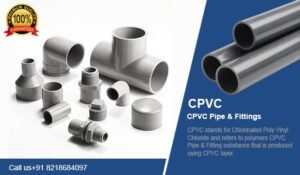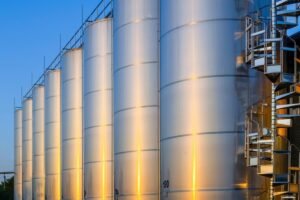Defining CPVC pipe fitting:
CPVC pipe fittings, also known as Chlorinated Polyvinyl Chloride pipe fittings, are made from CPVC compounded material. It has been one of the most durable and long-lasting materials used in piping applications for more than fifty years. Because CPVC is resistant to most aggressive chemicals and can withstand high temperatures and pressure, it is an excellent material for residential, commercial, and industrial piping and fire sprinkler applications.

CPVC pipe fitting jointing:
- Solvent Jointed CPVC Pipe Fitting: CPVC Pipe Fitting Plains such as Tee, Elbow, Socket, and End Cap are joined using CPVC solvent cement.
- Threaded Joint CPVC Pipe Fitting: It is a mechanical connection between two male and female Plastic/Brass Threaded CPVC pipes. Only Teflon tape should be used as a thread sealant in this case.
Approvals
- Conforms to ASTM F441 (pipe), ASTM F439 (Schedule 80 fittings) and
ASTM F1970 (flanges)
- Listed to 25/50 Flame Spread Rating and Smoke Developed Classification
as per ULC S102.2 for approved use in high rise construction and plenums
- Xirtec® 24 CPVC cement meets ASTM D2564 and is low VOC for LEED® projects
- Oxygen transmission rate conforming to ASTM F1927
Applications:
CPVC pipe fitting is used in a variety of applications.
- Water Supply: CPVC pipes are ideal for distributing hot and cold water in residential and industrial projects. They are used to transport drinking water and food liquids, as well as in water treatment plants.
- Chemical: CPVC pipes are used in chemical industrial plumbing. They are used to transport chemicals and hot corrosive fluids such as inorganic acids and bases used in chemical processing.
- Fire Sprinkler: These pipe fittings are commonly used in fire sprinkler applications.
CPVC compound is frequently used in the following industries for piping, ducting, sheeting, and linings. Thus one should purchase CPVC products from the best CPVC pipe manufacturers.
Chemical processing:
Transport aggressive chemicals reliably at high temperatures and pressures while avoiding corrosion concerns.
Compatible with:
- Hydrochloric acid
- Phosphoric acid
- Sodium chloride
- Sodium hypochlorite
- Sodium hydroxide (caustic soda)
- Sulfuric acid.
Common Applications:
- Manufacturing facilities
- Operations for blending
- Reagent reactions
- Scrubbing the air
- Operations involving wastewater treatment and demineralization.
Chlor Alkali:
Transport corrosive chemicals through some of the most corrosive environments while maintaining maximum service life.
Compatibility:
- Cell liquor (brine, sodium hydroxide)
- Sodium chloride concentrate (brine)
- Water that has been demineralized or deionized (DI).
- HCl (Hydrochloric Acid)
- Hypochlorite of sodium
- Sodium hypochlorite (Caustic Soda)
- Sulfuric acid
- Wet Chlorine gas.
General usages:
Pipes, tanks, headers, Chlorine drying towers and manifolds are all common applications of CPVC pipe fittings.
Difference between CPVC AND PVC:
The main distinction between CPVC and PVC is the temperature range each can withstand. CPVC can endure temperatures of up to 200° Fahrenheit, whereas PVC can only endure temperatures of up to 140° Fahrenheit.
Above those temperatures, both CPVC and PVC begin to soften, increasing the risk of joints and pipes failing and, as a result, the plumbing system failing.
Because of the differences in chemical composition, the primers, solvent cement, and bonding agents for PVC and CPVC are different. For example, CPVC solvent cement and PVC solvent cement must meet certain standards.
As a result, CPVC and PVC pipes and fittings and the solvents and bonding agents used with them should not be used interchangeably.
Special Consideration:
- Toxic fumes (dioxin and hydrochloride) are emitted when PVC or CPVC is heated, melted, or hot-cut.
- When working with PVC or CPVC, work in a well-ventilated area and wear proper safety equipment, such as gloves, goggles, and, if available, a respirator.
- Each material requires a primer and solvent cement (pipe glue) designed specifically for use with PVC or CPVC for solvent welding. The type of solvent cement used may differ depending on the pipe’s intended application.
- PVC costs less than CPVC, and both materials are less expensive than copper, iron, or stainless steel pipes.
- The nominal pipe size (NPS) sizing standard is used to size PVC pipes (NPS references the pipe interior diameter).
How is CPVC manufactured?
- Once the CPVC compound is delivered to the manufacturer, their responsibility is to transform it into a usable geometry with maximum chemical resistance. The compound must first be melted before processing can begin. The resulting melt must be injected into a suitable mould or pushed through a pipe die to form the final part geometry.
- Proper processing from the CPVC pipe manufacturers ensures that the areas where the melt comes together in the mould or after exiting the die fuse together properly.
If proper fusion is not achieved, these areas become vulnerable to chemical attack. Therefore, means correct fusion technique is highly important.
Variations in the pressure, temperature, concentration, installation, and maintenance of the CPVC material can all impact the system’s life expectancy. The pipe’s full hydrostatic pressure rating may not apply to the entire temperature and concentration range specified.
CPVC has many industrial usages. Petron Thermoplast makes affordable and efficient products of this type as market standards. You can purchase CPVC pipe fittings from us.





